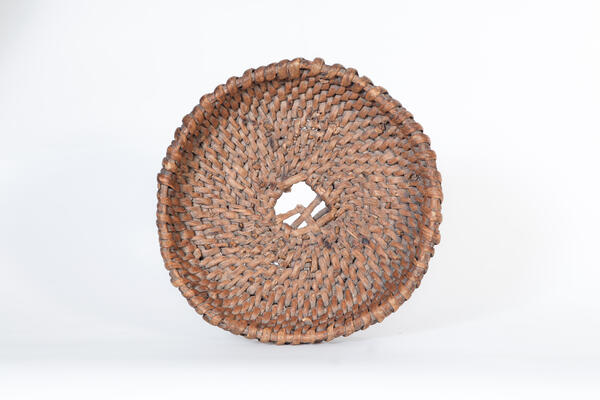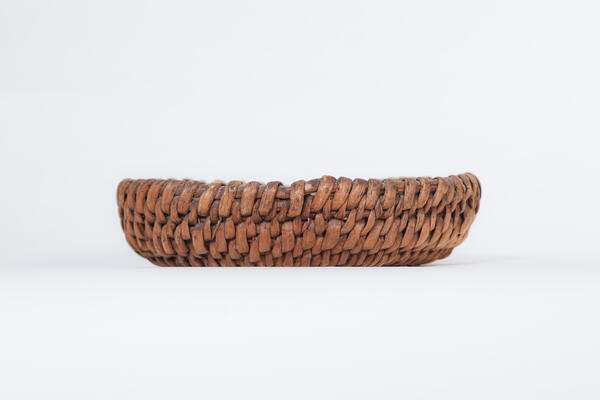A kornevatka vase (from the Russian “koren'” — root) is a round dish with low sides, made of thin tree roots in a checkerboard pattern. It is a household item and an important exhibit of the collection of ethnographic items made of wood, including wicker baskets, boxes, vases, dishes, a fodder basket and a headdress. The kornevatka was found in 1999 in the village of Ust-Chukurya, Gainsky district, Perm region.
The first kornevatkas, kornevatikas, kornyatkas, became part of the museum collection one hundred years ago when they were transferred from the Kudymkar State Art and Industry Workshops, founded by Pyotr Ivanovich Subbotin-Permyak, an avant-garde artist and the founder of the local history museum. In 2014, the collection was expanded to include the works by the folk craftsman of Perm Krai Leonid Sergeevich Bychin from the village of Bychino. He is the only living artisan in the region who makes wicker works from roots. Leonid Sergeyevich donated to the museum a wicker cap, a fodder basket, boxes, and vases.
Kornevtkas are rare because of the complex production technology. Unlike basketry of willow twigs or vines, production of kornevatkas require time to extract and prepare roots, as well as some physical strength for braiding. Traditionally, it was men who produced items made of roots. First, they stocked sarga — thin shingle, twigs or roots. For this purpose, cedar, pine or spruce roots were split into four parts and then a few thin layers were removed from the outer surface of the wooden part. These ribbons were cleaned of slivers and, if necessary, cut into narrower ones. Sarga, rolled into rings, was dried and stored until needed. The material soaked in water had the same properties as fresh material.
The technique of making a kornevatka involves pulling a running ribbon through a slit made with an awl on the braiding. Ribbons of cedar root should completely braid the bird cherry rod. At the end of the work, it is necessary to tighten the braiding so that the dish remains solid when drying. The shape of the kornevatka — round or rectangular — is determined by the form of the base made of twigs. The lid is made separately and then fixed with lace leather straps. The same straps are used to make a handle to carry the product. The main advantage of kornevatkas is their durability, as well as the ability to keep a stable leak-proof form.
The first kornevatkas, kornevatikas, kornyatkas, became part of the museum collection one hundred years ago when they were transferred from the Kudymkar State Art and Industry Workshops, founded by Pyotr Ivanovich Subbotin-Permyak, an avant-garde artist and the founder of the local history museum. In 2014, the collection was expanded to include the works by the folk craftsman of Perm Krai Leonid Sergeevich Bychin from the village of Bychino. He is the only living artisan in the region who makes wicker works from roots. Leonid Sergeyevich donated to the museum a wicker cap, a fodder basket, boxes, and vases.
Kornevtkas are rare because of the complex production technology. Unlike basketry of willow twigs or vines, production of kornevatkas require time to extract and prepare roots, as well as some physical strength for braiding. Traditionally, it was men who produced items made of roots. First, they stocked sarga — thin shingle, twigs or roots. For this purpose, cedar, pine or spruce roots were split into four parts and then a few thin layers were removed from the outer surface of the wooden part. These ribbons were cleaned of slivers and, if necessary, cut into narrower ones. Sarga, rolled into rings, was dried and stored until needed. The material soaked in water had the same properties as fresh material.
The technique of making a kornevatka involves pulling a running ribbon through a slit made with an awl on the braiding. Ribbons of cedar root should completely braid the bird cherry rod. At the end of the work, it is necessary to tighten the braiding so that the dish remains solid when drying. The shape of the kornevatka — round or rectangular — is determined by the form of the base made of twigs. The lid is made separately and then fixed with lace leather straps. The same straps are used to make a handle to carry the product. The main advantage of kornevatkas is their durability, as well as the ability to keep a stable leak-proof form.





